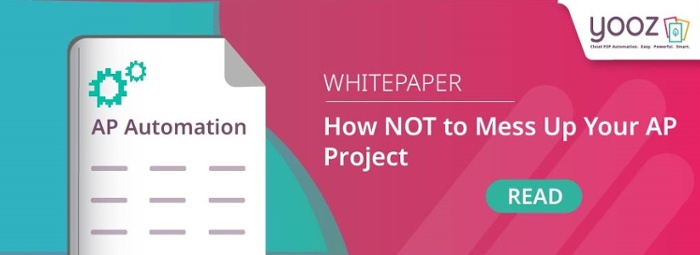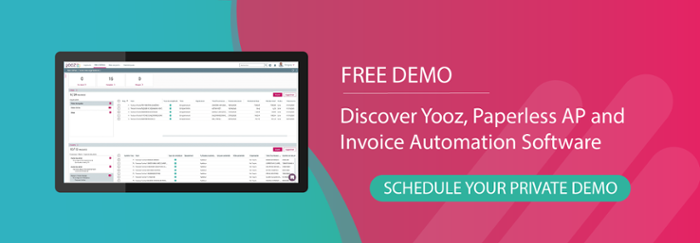What is an exception? By definition, it is an unusual event that deviates from expected standards enough to warrant further inspection and, if necessary, corrective action. It is a nightmare word in the accounting process and can have far-reaching effects. Just imagine the mistakes that can occur on an invoice - a name, a purchase order code, even a misplaced decimal point that changes the total amount due - and the devastating results this can have on an entire business.
If an organization still relies on a manual workflow for processing its invoices, the process of searching, finding, and correcting these exceptions will be the responsibility of the accounts payable team. In fact, invoice exception management is just one more item on their daily "to-do" list that turns handling invoices and other documents into a tedious, repetitive, and time-consuming process. The more exceptions, the longer it takes to get the work done.
Indeed, companies across a wide range of industries are well aware that exceptions are a problem that they need to address. In fact, in the recently released “AP 2022 Pulse on the Mid-Market” report by Ardent Partners, market researchers noted that finance departments consider identifying invoice exceptions as a major obstacle to them being efficient:
“The most commonly reported challenge facing mid-market AP teams is invoice exceptions, which can create severe bottlenecks in the AP process and greatly diminish overall productivity and inhibit AP staff from attacking more strategic activities. Invoice exceptions are also a primary cause of higher processing costs and lengthy approval times. Exceptions can be eliminated by leveraging ePayable solutions that ensure all required data, in the proper format and fields, is included on an invoice before it is routed for approval.”
This isn't just an opinion: companies that have implemented automation - specifically automated invoice processing software - have a proven method invoice exception management from end-to-end, from discovering them to a customized handling approach, all for a fast and accurate invoice workflow.
Why Do Exceptions Even Exist?
It is helpful to take a closer look at where these red-flag events know as exceptions come from and how to prevent them. From the moment an invoice arrives, the accounts payable (AP) team has to make sure it is captured, entered into the system, and then swiftly processed in order to review and approve it for (eventually) payment. It sounds simple but in reality, there are many steps in a manual process where things can go wrong.
An invoice, at its most basic level, is a collection of data points that describe what goods or services were delivered when, in what quantities, and when payment is due. If a team member has to pry invoices from an envelope or fax machine or review them as an email attachment, there is a fair chance that numbers can be mixed up, long strings of digits truncated or mistyped, or even entire documents accidentally misplaced.
Even before an invoice is keyed in, it can already contain errors that were created right at the source, such as incorrect items on the bill, mismatched quantities, a garbled bank account number or duplicate invoice number.
Heavy-Handed: Why a Manual AP Process Causes More Exceptions
The manual way is, by its very nature, error prone. It also requires humans who are already dealing with a steady flow of paper to get it right every single time. Otherwise, mistakes can and will slip through, leading to erroneous payments or hold-ups that have the potential to rankle suppliers waiting for their money. Ardent has some chilling numbers on what that means for the overall productivity of the AP function:
“Invoice exceptions remain a major problem for AP departments. In 2022, almost one-quarter of all invoices processed required exception handling due to bad or missing data. The inordinate amount of time AP staff spends correcting and managing invoice exceptions significantly increases the cost and time to process invoices.”
That’s not an abstract concern but rather one that can be measured. According to Ardent, this year AP staff across the board will spend almost one-third of their time working directly with suppliers to fix invoice, processing, and payment errors.
Let that statistic sink in: One-third of valuable staff time could easily be saved.
Assuming a 40-hour work week, we are talking about 13 hours wasted every week that could be used for other, more value-added tasks. If, that is, a cloud-based platform is ready to handle the grunt work of flagging exceptions.
Automation: Multi-Channel Capture and Machine-Learning Weed out Exceptions
Here is how it should work when a cloud-based platform such as Yooz handles invoices end-to-end. Multi-channel capture means that every invoice, regardless in what shape or form it arrives, is quickly and accurately ingested and prepped for further processing. Paper-based submissions or file attachments with unstructured data undergo optical character recognition (OCR) before digital, machine-learning algorithms get to work to automatically extract all relevant information.
In addition, most cloud-based platforms have already seen (and are familiar with) lots of invoices. Yooz, for example, has processed more than 100 million documents from tens of thousands of vendors, all of which are full of idiosyncrasies and peculiar formats. A smart system won’t be stumped by differently placed fields and instead can rely on its large and constantly growing training set to draw inferences about what data to look for on the page.
The Matching Game: AP Automation Excels at Flagging Errors
Unlike a manual-based process, automation is able to perform three-way matching for every invoice in a matter of seconds, comparing salient data points from a purchase order and a delivery receipt with the invoice in question. For example, you may have experienced:
- Ordering 20 chairs and only receiving 14
- Requesting item X but suddenly receiving item Y instead
- An increase in the agreed-upon price between order and delivery,
- A PO which stipulated different terms
- When the bank account on file suddenly doesn’t match what’s on the invoice
- If the invoice number has been used before
In each of these cases and more, the system will notice any discrepancies and escalate the irregularity for human review. On the other hand, if all details match up, the invoice is automatically GL-coded and moved along to the right people for review.
Why Straight-Through Invoice Processing Pays Off
In the automated world, humans only step in for approval or when a red flag goes up. Then, and only then, should they bring their wits and experience to bear to keep the workflow running smoothly. This is what experts refer to as “straight-through” processing. Surprisingly, in the “AP 2022 Pulse on the Mid-Market” report Ardent found that less than one-third (30.5%) of invoices will achieve this or touchless state (a number basically unchanged from the previous year). In other words, there is a lot of room for improvement to digitize and automate affairs.
Also, being stuck with paper and its inherent limitations and error rates can have sizable costs. The average price tag to process an invoice manually is $12.40, not to mention cycle times of close to two weeks (12.9 days). That tally doesn’t even consider the staff time wasted on chasing down errors, being on the phone with impatient vendors, dealing with late payment fees racked up after the due date, and clawing back monies that were paid out for duplicate or false invoices.
Going the route of automated invoice processing, on the other hand, cuts processing costs by 80% and reduces cycle time to a few days or even hours. Many organizations that have embraced digitalization and automation report paying invoices the same day, thereby locking in all available early-pay discounts and avoiding late fees. Certainly, nobody is going to complain about making money while paying bills!
Working Remotely, Catching Exceptions Remotely
Working outside the office is a topic that gained more urgency during the pandemic as back-office staff was thinned out, dispersed, and working remotely. If satellite offices had to pack up and mail invoices, POs or expense reports to a basically deserted head office, processing delays were hard to avoid. What’s more, B2B payment fraud attempts surged during the work from home mandates, as bad actors tried to take advantage of the poor visibility among all involved.
A cloud-based platform ensures that the workflow around POs and invoices never grinds to a halt, since every team member can now review and approve submissions on their desktop or mobile device, anytime and from anywhere. Once the system routes invoices for approval or flags them as an exception, all related files to drill down and answer questions are already securely stored in the cloud. They are instantly available, based on the right set of customizable permissions. And thanks to automatic indexing, queries for keywords and specific numbers are as easy as doing a web search.
Automation, therefore, is hands-down the best and most cost-efficient approach to deal with exceptions in a timely and reliable manner. That’s also due to the fact that an intelligent platform lets an organization define and continuously tweak rules around handling invoices. If, for instance, a certain amount is exceeded, a due date is unusually close or if a key vendor deserves special attention to ease looming supply chain issues, the system can take action such as speeding up the routing of these documents to specialists on the team.
Make no Mistake: How to Set up Error-Free B2B Payments
Exception handling done right isn't just about the first half of the invoice processing workflow but extends to the final part: payments. With payment fraud attempts on the rise and decreased staffing levels, organizations are hard pressed to make sure that they get what they ordered and only pay for what they ordered. Slipping up can have serious effects on their cash flow and also damage the relationships with key vendors.
Automation solves all those problems. Once reviews have taken place, the AP staff can quickly and easily use the same familiar interface to schedule and execute payments, ideally electronically. With YoozPay, the Yooz payment module, vendors can join this dynamic business network by just providing a single email address and selecting their preferred payment method.
The platform handles the rest, performing additional security checks around key metrics such as amounts, velocity and frequency, before sending off payment and payment notifications. Together the AP team and the supplier network are always in the know and can step in for corrective action and outreach if an exception were to occur.
Above all, a well-oiled system for accounts payable automation that gets smarter with every invoice it sees lets you accomplish one thing: It makes sure exceptions become the “exception to the rule.”

.jpg)




